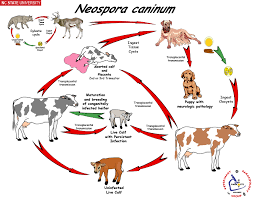Neosporosis in Dogs
What is Neospora Caninum?
There are many silent killers in this world, and cancer is usually the first one we think of. However, that is not the only silent lurker when it comes to pet disease. Neosporosis is a very deadly parasite that lives in infected cattle, mostly. This is important to note for pet owners that feed their pets raw diets or possibly live on ranches.
caninum is a protozoan parasite which can infect the cells and tissues of a wide range of warm-blooded mammals and occurs worldwide. Domestic dogs and wild dogs are the main hosts (‘definitive hosts’) for this parasite. Infected dogs shed the parasite in their faeces, which can result in the infection of other dogs or other mammals (i.e. cattle, sheep, horses and many other species) which are known as ‘intermediate hosts’.
Neosporosis parasites start as unsporulated oocytes, which are passed through feces, water, food, or soil. Once ingested, they live in the body and become sporulated. The final, and deadliest, is when they are fully grown into tachyzoites.
Neosporosis can affect any species of animal, whether they are domestic, captive, or wild. Neosporosis is also widely known to affect unborn animals, just like toxoplasmosis.
Canine Neosporosis is a microscopic protozoan parasite with worldwide distribution. A disease similar to toxoplasmosis, it attacks animal’s brain and spinal cord and slowly shuts down their body. Neospora caninum is a very deadly parasite that should not be taken lightly. Be aware of your dog’s whereabouts and do not feed them raw beef if at all possible. It could be a simple step in saving their life against a tragedy. If you are the owner of cattle as well, vaccinate your livestock to help prevent the spread of this deadly disease.
Symptoms of Neospora Caninum in Dogs
As with most parasitic diseases, symptoms may not always be prevalent until it is too late. When symptoms do show, they come on very quickly and progress rapidly. One account of a pet owner whose dog received Neosporosis after eating raw hamburger mince was that the symptoms showed up after only two days. Symptoms include:
- Hindlimb paralysis (commonly in puppies)
- Ulcers
- Pneumonia
- Peritonitis – an infection of the lining of the abdomen after a rupture
- Hepatitis
- Staggering
- Slow reflexes or reaction time
- Blindness
If you recognize any of these symptoms, take your pet to the veterinarian immediately. If it is caught in early stages, they can give your dog medicine to help treat the symptoms of neosporosis.
Types
There is only one kind of neosporosis, and that is neospora canum. Even though the disease is mostly spread by infected cattle, there is no other form of this parasite. It is very closely related to Toxoplasma gondii, which made it difficult to diagnose for years.
Norway was the first country to distinguish the difference between the two in the mid-1980s, naming Neosporosis as a muscular degeneration type disorder. Since its increase of cases and further studies, veterinarians now have the ability to tell the difference between Neosporosis and toxoplasmosis.
Causes of Neospora Caninum in Dogs
As previously mentioned, Neospora canum is transferred mostly by infected livestock, particularly cattle. This can be because a dog eats an infected, aborted placenta or from eating raw beef. Dogs will contract the parasites from eating tissue of an infected animal that has the parasite cysts in it.
Once the dog eats the infected flesh, the oocytes bursts and the life cycle starts all over again. The parasites create new oocytes in the dog’s body, which are shed through feces and then the cattle eat the infected soil which causes a full circle.
Diagnosis of Neospora Caninum in Dogs
There are many steps to diagnosis Neosporosis as it must be checked with complete accuracy. Without careful scrutiny, your pet could be misdiagnosed and not given the proper treatment. When in the hospital, your vet will perform tests such as:
- Biopsy
- PCR/Immunohistochemistry
- Serum Antibodies
- Smears
The veterinarians will use a polymerase chain reaction (PCR) to check for disruptions in the pet’s DNA due to parasites in the tissues. This is the most common and effective way to check for Neosporosis, although some veterinarians will do various biopsies to check tissues for parasites as well.
THERAPY
Information on effective therapy for this disease is limited. Clindamycin, sulfadiazine, and pyrimethamine alone or in combination have been administered to treat canine neosporosis. However, clinical improvement is not likely in the presence of muscle contracture or rapidly advancing paralysis. To reduce the chance of illness, all dogs in an affected litter should be treated as soon as the diagnosis is made in one littermate. Older (>16 weeks) puppies and adult dogs respond better to treatment. There is no known therapy to prevent a bitch from transmitting infection to her pups.
PREVENTION
In dogs, N. caninum can be transmitted repeatedly through successive litters and litters of their progeny. This should be considered when planning the breeding of Neospora-infected bitches. Dogs should not be fed uncooked meat, especially beef. There is no vaccine to combat neosporosis. No drugs are known to prevent transplacental transmission.
Treatment of Neospora Caninum in Dogs
Unfortunately, there is no full treatment for Neosporosis. If in small puppies, young dogs, or senior dogs the paralysis has already set in, it is too late. There are a set of drugs that can be given to help ease symptoms and provide comfort for your pet, but it is likely they will not recover.
The drugs that are commonly prescribed for Neospora caninum are clindamycin for about 4 weeks up to 8 weeks. They may also prescribe trimethoprim-sulfadiazine and pyrimethamine. For puppies, if one puppy is diagnosed, it is important that a pet owner distributes treatment to littermates before symptoms start showing.
Compiled & Shared by- Team, LITD (Livestock Institute of Training & Development)
Image-Courtesy-Google
Reference-On Request.

https://www.ndvsu.org/images/StudyMaterials/Parasitology/neosporosis-ppt.pdf


